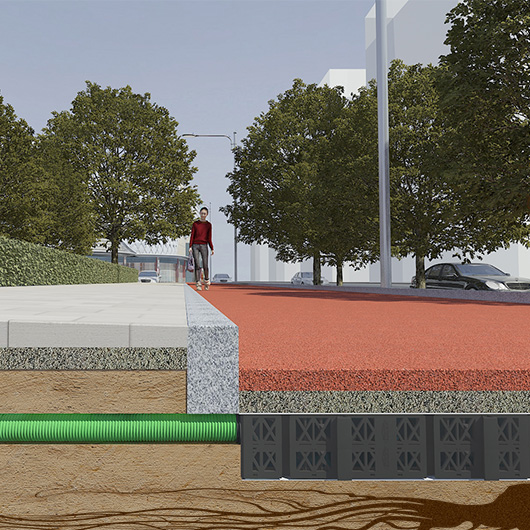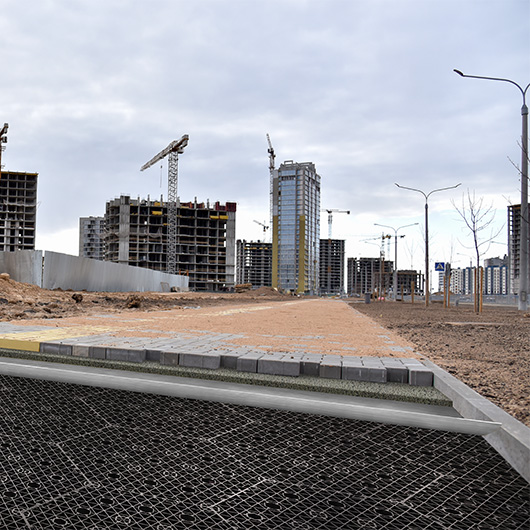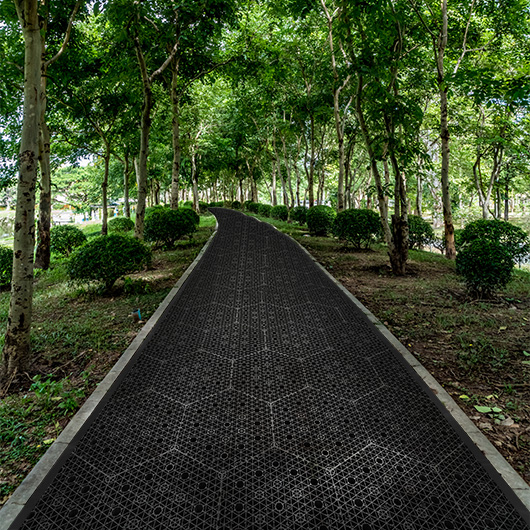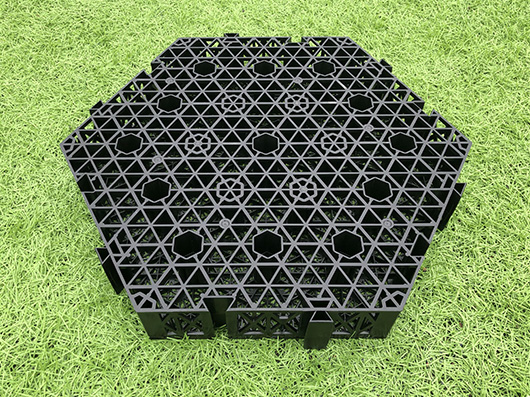Roads Application
Road Surface Drainage System and High-load Soakaway Crates
HOENSOEY CELLS is an incredibly robust and versatile underground drainage system, perfectly suited for environments demanding heavy-duty load bearing. Our product is meticulously designed and manufactured to withstand tremendous pressures, including the weight of heavy vehicles such as fire trucks. Its sturdy construction can endure long-term usage in harsh conditions without causing ground subsidence or surface damage. Whether on urban roads, parking lots, or industrial facilities, HOENSOEY CELLS deliver superior performance and reliable solutions, meeting drainage and load-bearing needs under various complex conditions.
Safe and reliable
Thanks to the ultra-high load performance (130 t/m²) of our heavy-duty HOENSOEY CELLS in the road surface drainage system, it helps to safely and reliably transfer the traffic load to the roadbed. Equipped with ultra-shallow cladding, there is no need to lay a large number of costly base stones. This also avoids the pollution of the roadbed and high groundwater level that traditional methods might cause. The ultra-shallow profile of our heavy-duty system minimizes excavation costs, while reducing stormwater surface runoff, which meets the goals of the stormwater assessment system BMP.


Distributed load
Road (Highway) surface drainage system with HOENSOEY soakaway crates can bear heavy traffic loads for a long time. Therefore, it can replace the traditional gravel sub-base to increase the safety and functionality of the road surface. When the soil quality of the roadbed is poor, the road surface drainage system can disperse the traffic load without complicating the problem due to the increase of the fixed load by laying the sub-base.
Fast drainage
When the soil quality of the roadbed is good, the road surface drainage system can be installed under the traditional impermeable pavement. In addition, HOENSOEY soakaway crates can achieve the permeable effect and maximize the infiltration area. For almost all roadbeds, the road surface drainage system can convert the traditional sub-base into a large-scale stormwater management tool that can realize the functions of water delivery and storage.

HOENSOEY Cell
HOENSOEY Cell(Soakaway Crates) is a new type of rainwater storage honeycomb unit designed to handle heavy-duty applications, thanks to its ultra-high compression strength and unique buckles. As a core component in shallow surface water treatment systems, they are primed for demanding environments where substantial strength and durability are paramount.
Common road drainage methods
There are three types of road drainage methods, including: open type, concealed type and mixed type. Street ditches, side ditches, drainage ditches can form open ditches and it is for the use of the drainage for open channels. The concealed type uses the hidden pipes for the drainage, including street ditches, storm drains, connecting pipes, main and branch pipes, and various inspection wells and water outlets, etc. The mixed type is a combination of open and concealed drainage.
1. Common drainage methods
1.1. Open drainage
Open drainage is mainly suitable for excavation of rock foundation and for sand gravel or coarse sand overburden. It is mostly for the discharge of rainwater and sewage on both sides of the road. This open-air drainage method is not aesthetic.
1.2. French drainage
French drainage mainly includes pipe drainage, rainwater outlet, various inspection wells and water outlets. Drainage facilities are under the surface layer by hidden methods to discharge rainwater and sewage, avoiding exposure and not affecting the aesthetics.
1.3. Osmotic drainage
Osmotic drainage is a way that can quickly seep rainwater from the pavement to underground space through the pores of the paving material. Then it collects the aquifer under the pavement, and transmits it to the municipal pipeline or lets it seep into the ground naturally. This kind of floor paving is common. Materials include pervious concrete, perforated bricks, etc. This method is both beautiful and practical.
2. Ecological drainage method
2.1. Vegetation swale
Vegetation swale commonly performs its duty on both sides of roads, the surrounding areas of impervious ground and large green spaces, etc. It connects to the network of rainwater pipe or water collection tank, and its surface is generally covered with grass.
2.2. Grassed swale
There are three types of grassed swale: standard conveyance swale, dry swale and wet swale.
The standard conveyance swales are open and shallow vegetation trenches. They do help in the drainage system of expressways. In areas with small runoff and low population density, they can replace roadside drainage ditch or rainwater pipe system.
Dry swales are open, vegetation-covered water transport channel. When used, the filter layer composed of artificially modified soil and the underground drainage system laid at the bottom of the filter layer have the ability to transmit, filter, infiltrate and retain rainwater. Therefore, it ensures that the rainwater is drained within the hydraulic retention time. To keep the grassed swale dry, there should be regular mowing in residential areas.
Wet swales are similar to standard conveyance swale systems. It is generally used in the drainage system of highways and the rainwater runoff of small parking lots or roofs. Since its soil layer remains wet for a long time, it may cause odor and hygienic problems such as mosquitoes and flies.
2.3. Biological retention pool
Biological retention pool is a shallow concave green space excavated by man. It can absorb rainwater on the roof or ground. It purities rainwater and absorbs it into the soil, and then conserves the underground water.
Regardless of the above drainage methods, the HOENSOEY soakaway crates can be the base material to achieve rapid drainage. In other words, they actually help to construct its ecological environment, which is economic and environmental-friendly.


 Arabic
Arabic Chinese (Traditional)
Chinese (Traditional) Dutch
Dutch English
English French
French German
German Italian
Italian Japanese
Japanese Korean
Korean Polish
Polish Portuguese
Portuguese Romanian
Romanian Russian
Russian Spanish
Spanish Swedish
Swedish